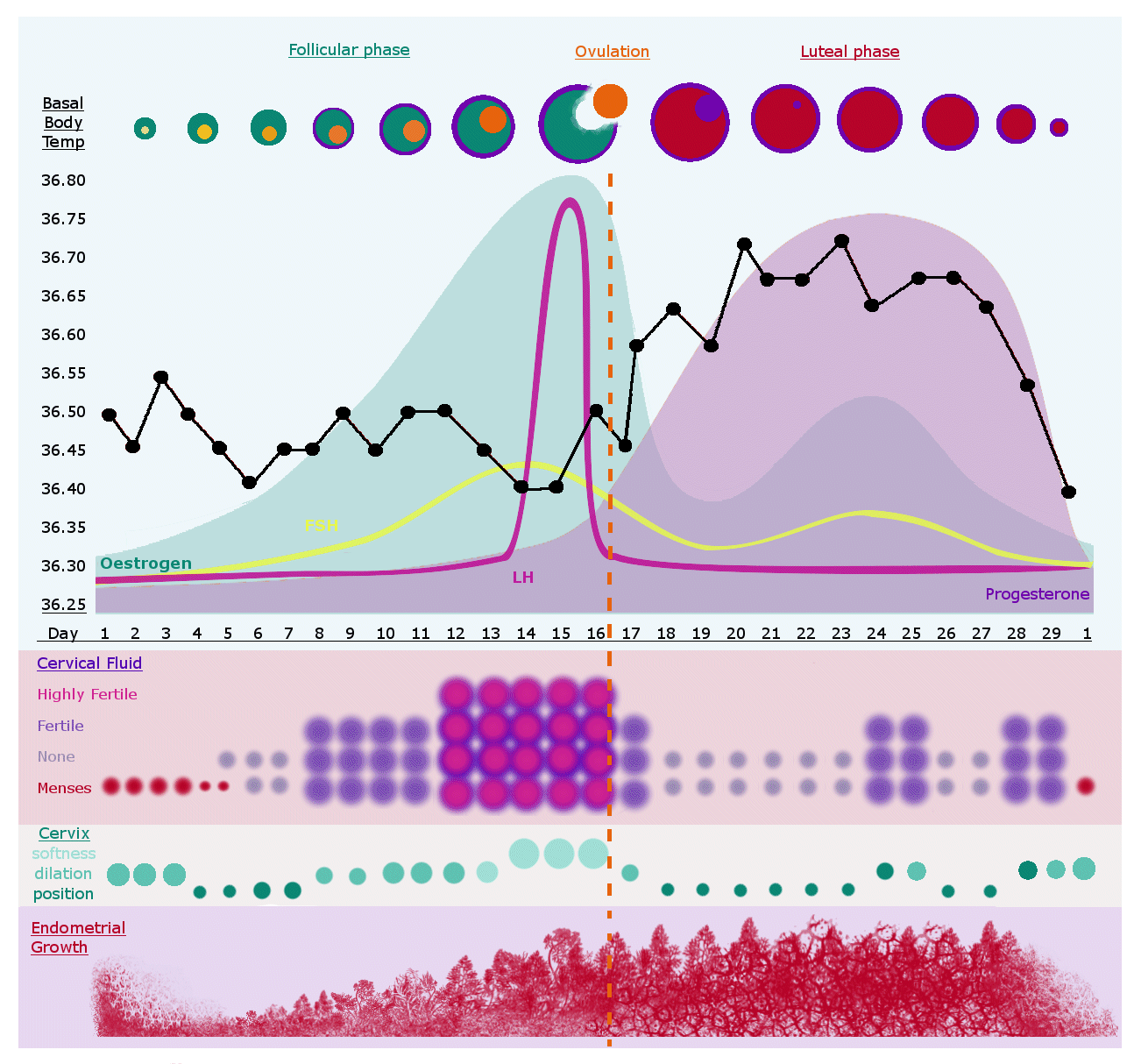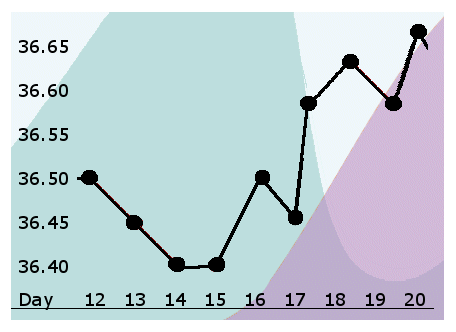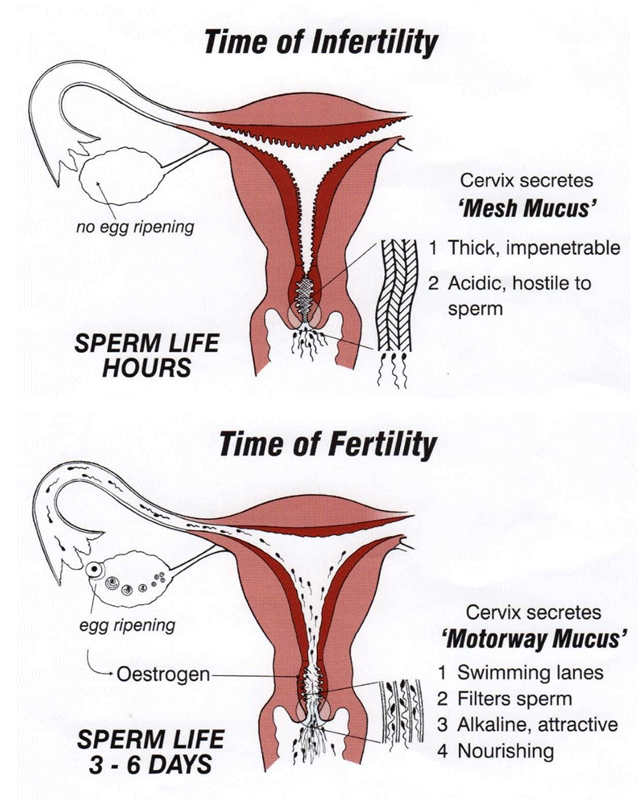
Fertility Awareness / Natural Family Planning
Email to express an interest: naturalshe.fertility@gmail.comClick here to find 'Natural She' on Facebook

Photo by Paul Talbot on Unsplash
The Science Behind Charting

What's Happening Hormonally?
The reproductive hormones are governed by the HPO Axis, an intricate feedback loop between three organs, the hypothalamus, the pituitary gland) and the ovaries.
When a girl reaches puberty, the hypothalamus starts to secrete gonadotropin hormones (GnRH), which stimulate the pituitary
gland to release two different hormones - Follicle Stimulating Hormone (FSH) and Luteinizing Hormone (LH), in different amounts throughout the cycle.
At the start of the cycle the pituitary gland is stimulated to release FSH into the blood stream. A handful of ova in the ovaries respond to the FSH and
start to grow. Usually one of them dominates while the others disintegrate, although fraternal twins are the result of more than one succeeding.

As the successful ovum continues to grow under the influence of FSH, it is continuously forming granulosa cells around it, which release oestrogen back in to the blood stream. Once the ovum reaches maturity (up to 2.4cm), the number of granulosa cells formed pushes the level of oestrogen in the blood over a threshold, which triggers the hypothalamus to stimulate the pituitary gland to release LH. In response to the surge of LH, the ovum/ova makes the first division and bursts out of the ovary (ovulation).

The follicle left behind re-forms into a corpus luteum, a relatively large cell of up to 5cm in diameter, which releases progesterone.
Once the balance of oestrogen in the blood is outweighed by progesterone, the hypothalamus is inhibited from secreting GnRH, in turn inhibiting the
release of FSH and LH from the pituitary gland. Progesterone thickens the endometrium (uterus lining), which developed under influence of oestrogen, so
that it has a denser network of capillaries in preparation for implantation of a fertilised ovum.
Meanwhile, any ovum that was released is guided into the fallopian tubes by fimbria (finger like projections at the end of the fallopian tubes),
where it may or may not be fertilised by any viable sperm who've made it. It only lives for up to 24 hrs and is only viable for fertilisation
for about 12 hrs.
If it is not fertilised, about 12-16 days later the corpus luteum disintegrates without the stimulation of Human Chorionic
Gonadotropin (HCG) from the fertilised ovum. This sudden drop in progesterone causes the endometrium to be shed, a
period or menstruation. The lack of progesterone allows hypothalamic
activity to return to normal, and the cycle begins again.
Primary Fertility Indicators
These are observable signs within the body which are controlled directly by the levels of ovarian hormones (oestrogen and
progesterone) in the blood - basal body temperature (BBT), cervical fluid / mucus and the cervix itself.
When we chart
these indicators consistently enough to be able to see the gradual and sometimes sudden changes they go through under
the influence of the ovarian hormones, it is entirely possible to determine your fertile and infertile phases.
However the knowledge required to do so is quite specific and should be learnt thoroughly before it is used as a sole method of contraception.

You can do this from various online tutorials and books if you have the confidence in your skills to educate yourself, and also through tuition where you are
likely to reach a level of confidence much faster and be able to ascertain from your tutor that your understanding is correct.
If special circumstances apply, such as post hormonal birth control, post-partum or you are having irregular cycles then I recommend the latter.
Basal body temperature is your resting temperature, defined as the lowest it settles at during a time of rest. The most
accessible way to measure it is with a basal thermometer on waking up, after at least 3 hours sleep. One of the effects of the rise in progesterone
provided by the corpus luteum just after ovulation, is an elevated BBT. The hypothalamus responds to progesterone by raising the metabolic rate and the BBT.
If taken the same way and at the same time each day, when compared on a chart, a pattern will emerge showing a sustained rise in progesterone just after ovulation.

Diagrams by Mrs Colleen Norman,
former Chairman of NFPTA
Cervical fluid is produced in the cervix in different ways throughout the cycle, and can be observed along with the vaginal
sensation. The quality observed will show you how much oestrogen is present. The cervix is the neck of the womb, forming a gateway to
the vagina and outside world. At the beginning of the cycle there is often little to no cervical fluid present and a 'dry' sensation at
the vulva, creating a hostile acidic environment for sperm and bacteria, protecting the uterus. Although you may not see it, there is a
thick mucus 'plug' within the cervix sealing it shut. If you do see some early in your cycle, it will likely be a thicker quality.
As oestrogen rises, fluid becomes wetter, more lubricative and finally stretchy, often compared to egg whites or aloe vera, indicating that
ovulation is close. Once the oestrogen is dominated by the progesterone, the highly fertile fluid dries up quickly, and, shown on a chart,
this is a clear indicator that ovulation has happened.
The cervix itself can be used as a third indicator, although for symptom-thermal rules it is not necessary.
In the early part of the cycle when oestrogen is low, it will sit lower down in the vagina and be firm and closed,
acting as a barrier to the outside world. As oestrogen rises the cervix rises up, making it harder to reach and it
opens up to allow fertile fluid out and sperm in. Again, once progesterone is dominant and ovulation is over, the cervix
shuts tightly and lowers. This can be one of the most sudden changes noticeable and makes an excellent third indicator when
the first two sometimes don't line up perfectly.
Secondary Fertility Indicators
Most of us are familiar with other secondary cyclical changes, but they are not consistent enough across the population to be used as a primary source for determining fertile phases. However, they may be consistent for you, and charting them can help you understand where you are in your cycle and why you might be experiencing them.
Breast Tenderness
A response to progesterone in the luteal phase - think preparation for pregnancy.Ovulation Pain
Ovulation can be a fairly violent event, the pain shouldn't be unbearable though.Mid Cycle Spotting
Can be around the time of ovulation, especially if the progesterone doesn't pick up quite in time and there is a momentarily lapse in oestrogen. Fairly normal, and without other symptoms, not a reason for concern. Spotting can also occur during the luteal phase which can indicate low progesterone. There are lots of reasons for various types of spotting and you may want to work with a holistic hormonal health specialist to find out the reason.PMS (Pre-Menstrual Syndrome)
Unfortunately, it is not fully understood yet why some of us get PMS. It can happen at any time during your luteal phase, usually with a pattern. Charting this can help you to understand it, prepare and forgive yourself!Anything Else Unique To You
You can of course chart any other signs or health issues you notice and see if you discover a pattern.
References
References are taken from the teacher training course by the NFPTA 2016, provided by Dr Maureen O'Carroll's Manual 'NFP Teacher Training Course'. She has kindly allowed us to publish them to show that NFP has scientific credibility. She spent many years collecting these references and contacting the authors for their permission. Much research work has been carried out by many people on the many different scientific and sociological aspects of Natural Family Planning to the benefit of all.
References - Cervical Mucus
- Morales P, Roco M, Vigil P; 'Human cervical mucus: relationship between biochemical characteristics and ability to allow migration of spermatozoa; Human Reproduction; vol 8 No 1 1993.
- Austin, C.R.; 'Sperm fertility, viability and persistence in the female tract'; J. Reprod. Fert., Suppl. 22 (1975).
- Moghissi KS,: 'Prediction and detection of ovulation'; Fertility & Sterility, August 1980; 34, No.2.
- Settlage, Diane S Fordney, et al; 'Sperm transport from the external cervical os to the fallopian tubes in women: A time and quantitation study' Fertil and Steril; Vol 24, No 9, Sept 1973.
- Hilgers TW, Prebil AM; 'The ovulation Method-Vulvar observations s an index of fertility/infertility'; Obstetrics & gynaecology, vol 53, no 1, Jan 1979.
- Odeblad E, 'Investigations on the physiological basis for fertility awareness; Bulletin for the Ovulation Method Research and Reference Centre of Australia, vol 29, no 1, p2-l 1, march 2002, (Billings Ovulation Method, www.woomb.org)
- World Health Organization; 'A prospective multi-centre trial of the Ovulation Method of Natural Family Planning 1; The Teaching Phase'; Fertility & Sterility; Vol. 36, no 2, Aug 1981; pages 152-158.
- Cohen M, Stein I, and Kaye B; 'Spinnbarkeit: 'A characteristic of cervical mucus; significance at ovulation time'; Fertil & Steril; Vol 3, no 3, 1952.
- Brown, JB; 'Ovarian activity and fertility and the Billings Method' (from the internet; Billings Life; 2005)
- Erik Odeblad; 'The discovery of different types of cervical mucus and the Billings Ovulation Method'; Bulletin of the Ovulation Method Research and Reference Centre of Australia, Vol 21, No3; Sept 1994. (on the internet if you google 'Erik Odeblad, cervical mucus')
- Flynn AM, Lynch SS; 'Cervical mucus and identification of the fertile phase of the menstrual cycle'; Br J of Obstet &Gynec; August 1976; vol 83.
- Billings,E,&J; Symptoms &Hormonal Changes accompanying ovulation; Lancet; Feb5; 1972.
- Hanson FW, Overstreet JW; 'The interaction of human spermatozoa with cervical mucus in vivo'; Am J Obstet. Gynecol, 1981.
- Brown JB, Blackwell LF, Holmes J, Smyth K; 'New assays for identifying the fertile period'; Int J Gynecol. Obstet., 1989.
- Moghissi KS, Syner FN, Evans TN; 'A composite picture of the menstrual cycle'; Am J Obstet. Gynecol. 1972.
- Billings Dr Evelyn & Westmore Dr Ann; 'The Billings Method';(2008); ISBN 1 876026 42 1
- Hoff, JD, Quigley ME, Yen SC; 'Hormonal dynamics at mid-cycle: a re-evaluation'; J Clin Endocrinol Metab; 1983; vol 57, No 4.
- Bigelow LB, Dunson DB, Stanford JB, Ecochard R, Gnoth C, Colombo B; 'Mucus observations in the fertile window: a better predictor of conception than timing of intercourse'; Human Reproduction; 2004;vol 19; No 4.
References - Basal Body Temperature
- Marshall, J; A field trial of the basal body temperature method of regulating births; Lancet, 1968,July, 8-10
- Manassiev Nikolai, Whitehead, Malcolm; 'Female Reproductive Health'; 2004, ISBN 1-85070-491-0
- Griffin James E, Ojeda, Sergio R; 'Textbook of Endocrine Physiology'; 1996, ISBN 0-19510755-1
- Marshall, John; Planning for a Family, an atlas of temperature charts 1965; Faber and Faber Limited, London
- World Health Organization: WHO Task force on methods for the determination of the fertile period; temporal relationship between ovulation and defined changes in the concentration of plasma estradiol17 (3, LH, FSH, and progesterone. Special Programme of Research, Development and Training in Human Reproduction. Am J Obstet Gynecol 1980
- Vollman, Rudolf; 'The Menstrual Cycle' 1977; Saunders Company; ISBN 0-7216-9075-0
- Kippley, John & Sheila: The Art of Natural Family Planning; 4th edition; 1997; The Couple to Couple League International, Inc. PO Box 111184; Cincinnati, OH 45211-1184, USA. ISBN 0-926412-13-2
- Hilgers TW, Bailey AJ; 'Natural Family Planning -11. Basal Body Temperature and Estimated Time of Ovulation' Obstet & Gynec March 1980, vol 55.
- Moghissi Kamran; 'Accuracy of basal body temperature for ovulation detection'; Fertil. Steril;Dec 1976; vol 27, No 12
- Moghissi, Kamran; 'Prediction and detection of ovulation'; Fertil, Steril; August 1980; Vol 34; No 2
- Moghissi, KS, Syner FN, Evans TN; 'A composite picture of the menstrual cycle'; Am J. Obstet. Gynecol; Oct.l 1972; vol.114; No 3
- Roetzer, Josef; 'The symptom-thermal Method: Ten Years of Change'; Linacre Quarterly; November , 1978.
- Hoff, JD, Quigley ME, Yen SC; 'Hormonal dynamics at mid-cycle: a re-evaluation'; J Clin Endocrinol Metabolism; 1983; vol 57, No 4.
- Bates, GW, Garza DE, Garza MM; 'Clinical manifestations of hormonal changes in the menstrual cycle'; Obstetrics and Gynaecology Clinics of North America; Vol. 17; No 2; June 1990.
- Schoupe D, Mishell DR Jr, Lacarra M, et al: 'Correlation of endometrial maturation with four methods of estimating day of ovulation. Obstet Gynecol 73:88, 1989.
- Squire WS: Puerperal temperatures. Trans Obstet Soc (London) 1868:.
- Van de Velde TH: liber den Zusammenhang zwischen Ovarialfunction, Wellenbewegung und Menstrualblutung und uber die Enstenhung des sogenannten Mittelschmertzes. Haarlem. De Erven F. Bohn. 1904.
- Van de Velde TH: Die Vollkommene Ehe: Eine Studie uber ihre Physiologie une Technik. Leipzig. Sttutgart: Benno Konegan. 1926.
- Martinez AR. van Hooff MHA. Schoute E. van der Meer M. Broekmans FJM. Hompes PGA: "The reliability, acceptability and applications of basal body temperature (BBT) records in the diagnosis and treatment of infertility": European Journal of Obstetrics & Gynaecology and Reproductive Biology: 47 (1992)
- Porterfield SP, White BA; 'Endocrine Physiology'; Mosby Physiology Monograph series; 3rd edition; 2007; ISBN 13:978-0-323-03666-5
- Newill RGD, Katz M; 'The basal body temperature chart in artificial insemination by donor pregnancy cycles'; Fertil Steril; 1982.
- Frank-Herrmann Petra, Gnoth C. Baur S et al 'Determination of the fertile window: Reproductive competence of women- European cycle databases': Gynaecological Endocrinology: June 2005. Vol 20. issue 6. P305-312
References - Cervix
- Keefe, E.; 'Self-observation of the cervix to distinguish days of possible fertility'; Bull of the Sloane Hosp for Women; 1962.
- Flynn A, Brooks M; 'The Manual of Natural Family Planning'; 1996; ISBN 0 7225 3115 X
- Roetzer, Josef; 'The symptom-thermal Method: Ten Years of Change'; Linacre Quarterly; November, 1978; 358-374.
- Keefe, E.; The cervix as a guide to control of conception by selective abstinence' ;article in 'A Reader in Natural Family Planning'; Report on international conferences; No. 1, second edition; The Human Life Center, St John's University, Collegeville, Minnesota, USA; Printed by Seta International Printing Co., Tokyo; 1978
- Brosens I, Hernalsteen P, Devos A, Cloke B, Brosens J; 'Selfassessment of the cervical pupil sign as a new fertilityawareness method'; Fertil Steril; March 2009; Vol 91; No 3.
- Flynn Anna, Lecture on a Review of the development of natural family planning given in Birmingham in 1988; printed in the 1998 edition of the NFPTAI Teachers' Training Manual.
- Parenteau-Carreau S, Infante-Rivard C, 'Self-palpation to assess cervical changes in relation to mucus and temperature, Serena, Canada. Int J Fertil; 1988.
References - Menstrual Cycle
- Yussman MA, Taymor ML; 'Serum levels of follicle stimulating hormone and luteinizing hormone and of plasma progesterone related to ovulation by corpus luteum biopsy'; J Clin Endo 30;396;1970
- Espey, LL, Ben Halim IA; 'Characteristics and control of the normal menstrual cycle'; Obstetrics and Gynecology Clinics of North America; Vol. 17; No 2; June 1990.
- Griffin JE, Ojeda SR; 'Textbook of Endocrine Physiology 3rd Edition, 1996,; Oxford University Press, ISBN 0-19-510755-1
- 4. Pearson International Edition; 'Principles of Human Physiology'; 3rd edition; 2008; Cindy L Stanfield, William J Germann, ISBN 0-321-45428-6.
- Alvero, R, Schlaff WD; 'Reproductive endocrinology and Infertility'; The Requisites in Obstetrics and Gynaecology; Mosby, Elsevier; 2007; ISBN 0-323-04054-3.
- Manassiev Nikolai, Whitehead, Malcolm; 'Female Reproductive Health'; 2004; Parthenon Publishing Group; ISBN 1-85070-491-0 7. Vigil, P, Ceric, F, Cortes ME, Klaus H; 'Usefulness of Monitoring fertility from menarche'; J Ped. Adolesc Gynecol (2006).
- Hodgen, Gary D; 'Neuroendocrinology of the normal menstrual cycle; The Journal of Reproductive Medicine; 1989; vol 34.
- Miro, F; Aspinall, LJ; 'The onset of the initial rise in follicle stimulating hormone during the human menstrual cycle'; Human reproduction; vol 20; No,l, 2004
- Flynn, Anna; Br J Ob Gyn; 1976; 83; 656 12. Hoff, JD; Quigley, ME; Yen, SC; 'Hormonal Dynamics at mid-cycle: a re-evaluation'; J Clin Endocrinol Metab; 1983; Vol 57, No 4.
- Brown James B; 'Ovarian activity and fertility and the Billings Ovulation Method, Physiology of ovulation'; 2005.
- Klaus H; 'Natural family planning - is it scientific? Is it effective? Newman lecture series 1; May 21, 2000. (Internet, search 'natural family planning, Dr Hanna Klaus').
- Moghissi, Kamran; 'Prediction and detection of ovulation'; Fertility and Sterility; vol 34, No.2 August 1980. 16. Kerin JF, Edmonds DK. Warnes GM et al, 'Morphological and functional relations of Graafian follicle growth to ovulation in women using ultrasonic, laparoscopic and biochemical measurements'; Br J Ob/Gyn; Vol 88 No 2; Feb.1981
- Brown, James B in Appendix 3 of 'Teaching the Billings Ovulation Method' by Evelyn and John Billings; www.woomb.org
- McNeely M, Soules M; 'The diagnosis of luteal phase deficiency: a critical review'; Fertil Steril, 50, No 1, 1988, 1-15.
- Porterfield SP, White BA; 'Endocrine Physiology'; Mosby Physiology Monograph series; 3r d edition; 2007; ISBN 13:978-0-323-03666-5.
- Pearson International Edition; 'Principles of Human Physiology'; 3rd edition; 2008; Cindy L Stanfield, William J Germann, ISBN 0-321-45428-6.
- Griffin JE, Ojeda SR; 'Textbook of Endocrine Physiology 3rd Edition, 1996,; Oxford University Press, ISBN 0-19-510755-1
- Henderson's Dictionary of Biological Terms; 11th edition; edited by Eleanor Lawrence; Longman; 1997; ISBN 0-582-22708-9
- Alvero, R, Schlaff WD; 'Reproductive endocrinology and Infertility'; The Requisites in Obstetrics and Gynecology; Mosby, Elsevier; 2007; ISBN 0-323-04054-3
- Greenstein B, Wood D; 'The Endocrine System at a Glance'; 2nd edition; Blackwell Publishing; 2006; ISBN 978-1-4051-0930-7
- Lamb N, Manson A; 'Cell Biology and Genetics' Crash Course; 2007; Mosby; ISBN-10:0-323-04494-8.
natural fertility,natural fertility,natural fertility,natural fertility,natural fertility,natural fertility,natural fertility,natural fertility,natural fertility,natural fertility,natural fertility,natural fertility,natural fertility
natural fertility,natural fertility,natural fertility,natural fertility,natural fertility,natural fertility,natural fertility,natural fertility,natural fertility,natural fertility,natural fertility,natural fertility,natural fertility